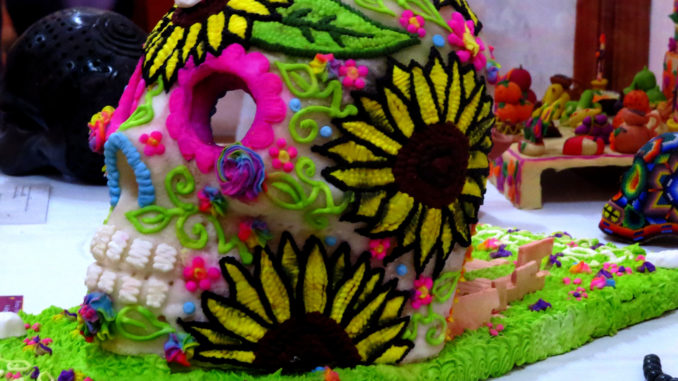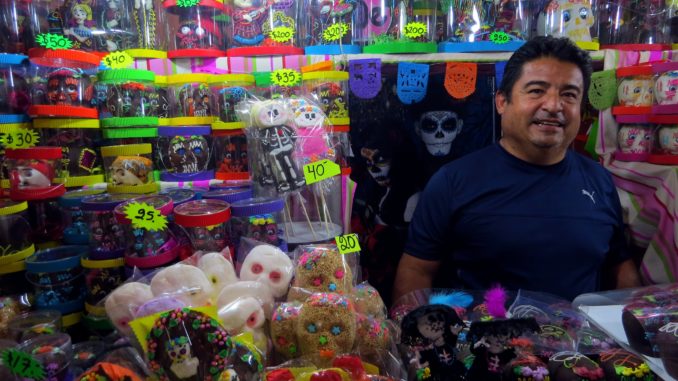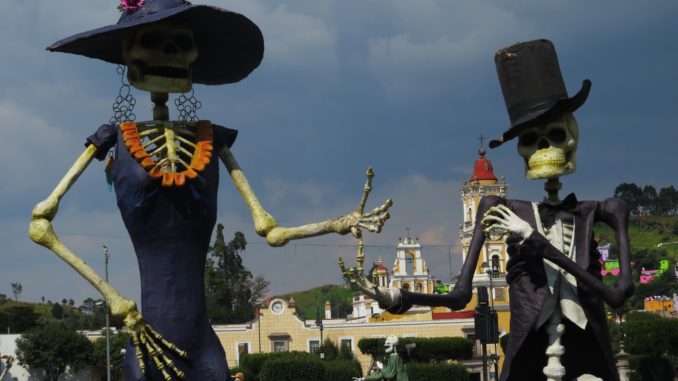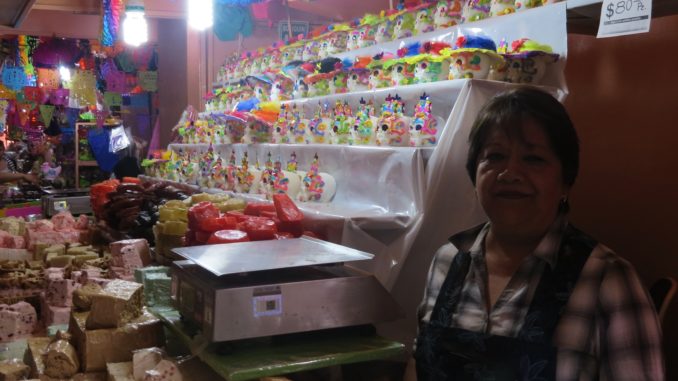
Mexico’s sugar skulls make death beautiful, political, and humorous – but many in the West wouldn’t consider them art. In reality, it is a snobbish and somewhat racist notion that art has to be done in the Western way to be art, and that it has to be locked up in art galleries and sold at elitist prices to be taken seriously.
Too often, art produced in poorer countries is dismissed with the inferior category of “handicrafts.” But strolling through the Alfeñique fair (roughly: sugar skulls) over the weekend and talking to some of the hundreds of artists selling the incredible skulls, it was clear they didn’t agree.
“It takes us two months to make all this, and we do it all by hand,” said sugar skull artist Marco Antonio Garcia Gonzalez.
“This is art – we think about the designs, and we change the designs each year. We combine tradition with what we’re going through in the present, with modernity. Here in Mexico, we believe in honoring the dead, who are always with us. So people take this very seriously and they look for something special for their ofrenda (offering or Day of the Dead altar in this context). This art is emblematic of Mexico,” commented Jose Antonio Nava.
The fair is being held for two weeks in the city of Toluca, in the lead up to the Day of the Dead. In the center of the city, there are around 100 stalls selling skulls made out of the special sugar paste, or the indigenous amaranth mixture, or chocolate. Papel picado (decorative paper-cut designs) and other objects used in the Day of the Dead offering are also available. Each stall is run by an artist or by a family or group, and each has a unique design. All of their skulls are handmade, though the smaller ones, available for just a dollar or two, were clearly made quite quickly.
“I consider this art. Death happens to everyone, and what we are doing here is representing that. We’re also protecting a culture from pre-hispanic times. The skulls we make mean a lot. We put them in our ofrenda and then after the Day of the Dead we eat them and enjoy them,” artist Araceli Sanchez Millán told me.
Collective Artistic Expression

In the Western world, artistic skill is relegated to the individual – to a few art heroes. But art in which whole communities and masses of people participate has deep social and creative value.
Alfeñique is “true popular art, which on being eaten and looked at … we don’t give it the importance it should have, as a work of art by the people. However, these are real sugar sculptures, made from a material that is infinitely more difficult to work with than clay,” wrote Maria Teresa Pomar, an expert in Mexican popular art.
Art – including these sugar skulls, and including murals and Mexico’s vibrant alebrije creatures – when it is made by the people, for the people, counters the idea that creativity is for elites. It can send a strong political message: Mexico and its indigenous peoples are deserving of dignity and respect, and Mexico has an identity beyond the narcos featured in Hollywood movies, and beyond the right-wing’s boring stereotypes.
But Western narratives – tourism articles and guides and other content – tend to dismiss the sugar skulls as “handicrafts,” “souvenirs,” or, at best, “folk art,” – viewing the art in terms of how it serves them, and letting price tags and Western art ideals of individualism and innovation dictate the creative value they have.
In the US, it seems, white people are also happy to commercialize, co-opt, and profit from the Day of the Dead and its symbols, while being less willing to recognize Mexico’s artistic leadership. UNESCO, at least, does recognize the Day of the Dead as Intangible Cultural Heritage of Humanity.
Skulls and Sugar: Mocking the Invaders

The Day of the Dead, celebrated from the 31st of October through to the 2nd of November, is a celebration of life, a homage to one’s ancestors, and a mockery of death. Up until at least 3,000 years ago, people in the region have venerated the bones of dead family members as a way of communicating with the spiritual world, and the Mexicas and Aztecs used skulls as an important symbol in temples, and an object of power. The Aztecs held a festival in celebration of the goddess Mictecacihuatl, the “lady of the dead” who watches over the bones of the dead. After the Spanish invasion, the Day of the Dead also took on some Christian characteristics.
Then, in the early 1900s, Jose Guadalupe Posada etched Catrina (La Calavera Catrina), among other etchings. He drew her as a skull – a symbol of Mexicans – dressed in a fancy hat – a symbol of the European elites, to represent those Mexicans who aspired to European or elitist cultures. Now, she forms a major part of the Dead of the Dead celebrations, being featured among the sugar skulls, in sculptures, and in dress-ups and parades.
The technique for making the sugar skulls varies from region to region and artist to artist: in Puebla state almonds, peanuts, pumpkin seeds, and egg are often used, while in Oaxaca honey is common. The sugar paste originally came from Persia, was adopted in Spain, then brought to Mexico, where people already had figures for their ofrendas made from amaranth. Today, people create ofrendas in their homes – with three levels representing the material and immaterial world, or seven to eight levels, for the tests the Aztecs believe souls have to pass. Different communities, schools, work places, and peoples also sometimes build collective ofrendas, with the Tlahuicas, for example, holding a ceremony and remembering dead leaders and authorities, and the Matlatzinca creating an arch, with arrangements in the shape of the sun, to light up the souls of the dead. They also use bread in the shape of animals.
Using the Term “Handicrafts” to Denote Inferiority

Some of the skulls on display at the Toluca fair are quite simple, and when we think of handicrafts, we often think of something bit less involved than “real art.” But Andy Warhol’s Skulls (1976), for example, was also pretty simple – so is there any truth to this distinction between “art” and “handicrafts,” or are the terms a convenient way to elevate some types of art, and debase others?
Art, according to Merriam Webster and Collins, is “The conscious use of skill and creative imagination in the production of aesthetic objects … for people to look at and admire or think deeply about.” There’s nothing in that definition that rules out Mexico’s sugar skulls. You could also argue that craft is reproduced repeatedly, according to a formula, but Western-recognized artists also follow styles and movements. You could argue that gallery paintings sell art for more – but that’s a reflection of the inequality in the arts, rather than a cause for the distinction.
A New York Times article questioned if “high art” had to mean “better” art, with the author making a very valid point: “Given the adulation and money poured into the high art world by collectors and corporations … Maybe the ‘vision thing’ is a marketing strategy for a lot of artists.”
In fact, the idea of an artist in the West didn’t exist until the European renaissance, when painters stopped being paid by the square foot of painting, and instead were paid based on merit, art historian Laura Morelli argued. Painters and sculptures were “elevated to rock star status” while those still producing candlesticks, ceramic vessels, and gold jewelry were known as artisans. Their work was considered decorative and inferior.
Today, the main difference between what is considered art or handicrafts has a lot to do with who is making the art, and who is buying it: if it is a well-off white man, or a poor, Mexican indigenous woman. The distinction between the two terms creates a hierarchy of value, with Western art elevated above art from Africa, Latin America, and parts of Asia.
The consequences of such a hierarchy are severe: so called “artisans” work in anonymity, earning less, being taken less seriously, with their whole culture devalued. Ultimately, I think the skull art and alebrije of Mexico deserves rock star status too.
Tamara Pearson has been teaching creativity and imagination in schools in Venezuela and Mexico for five years, has been a journalist for 17 years, is the author of The Butterfly Prison, and blogs at Resistance Words.
